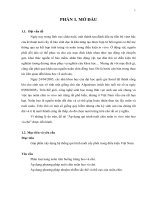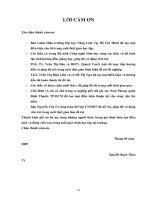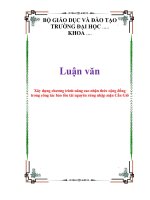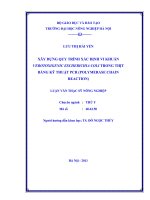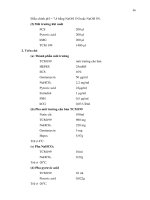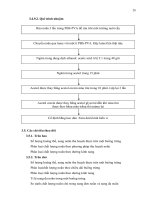Luận văn : Áp dụng qui trình nuôi chín noãn in vitro trên heo và chó part 5 doc
Bạn đang xem bản rút gọn của tài liệu. Xem và tải ngay bản đầy đủ của tài liệu tại đây (631.52 KB, 9 trang )
37
Hình 4.4: Nhuộm noãn chó đạt
giảm phân (a), (b), (c)
Hình 4.3: Nhuộm noãn chó
không đạt giảm phân
Hình 4.2: Vị trí đặt mỡ bò lên
lame
(a)
(b)
(c)
38
Hình 4.5: Thu nang noãn trên heo bằng phƣơng pháp cắt
Hình 4.6: Thu nang noãn trên heo bằng phƣơng pháp hút
Hình 4.7: Thu nang noãn trên chó bằng phƣơng pháp cắt
39
Hình 4.8: Hình các loại môi trƣờng. (Từ trái qua phải: môi trƣờng rửa
noãn HEPES; 2 đĩa môi trƣờng nuôi noãn heo; môi trƣờng giọt nuôi
noãn chó)
Hình 4.9: Phƣơng pháp lấy noãn bằng kẹp
Hình 4.10: Phƣơng pháp tạo môi trƣờng giọt trên chó
40
PHẦN 5. KẾT LUẬN VÀ ĐỀ NGHỊ
5.1. Kết luận
Đề tài đã đạt được những kết quả sau:
- Đánh giá ban đầu các đặc điểm buồng trứng heo và chó. Là cơ sở cho
các nghiên cứu sau này có những hướng nghiên cứu mới.
- Đã áp dụng qui trình nuôi noãn heo và chó ở điều kiện phòng thí
nghiệm Đại học Nông Lâm. Mặc dù tỉ lệ thành công chưa cao, đã rút ra
những kinh nghiệm giúp người sau không mắc phải và tiết kiệm thời
gian nghiên cứu.
5.2. Đề nghị
- Tiếp tục đánh giá buồng trứng heo và chó. Trên heo đánh giá thêm
chỉ tiêu giống và tuổi. Trên chó đánh giá thêm buồng trứng ở các giai
đoạn của chu kỳ động dục.
- Hoàn thiện qui trình nuôi noãn trên heo và chó. Kết hợp bố trí thí
nghiệm để có thể so sánh sự khác biệt giữa kết quả đánh giá ban đầu và
kết quả sau khi nuôi noãn chín.
- Nghiên cứu tiếp sự phát triển của phôi sau khi thụ tinh và xác định
giới tính phôi.
41
PHẦN 6. TÀI LIỆU THAM KHẢO
TIẾNG VIỆT
[1] Nguyễn Tấn Anh, Nguyễn Quốc Đạt, 1997. Thụ tinh nhân tạo gia súc gia cầm.
NXB nông nghiệp.
[2] Nguyễn Tiến Dũng, Dương Đình Long, Nguyễn Văn Thanh, 2002. Sinh sản gia
súc. Nhà xuất bản Nông Nghiệp Hà Nội.
[3] Huỳng Thị Lệ Duyên, 2003. Ứng dụng kỹ thuật thụ tinh in vitro và dùng PCR xác
định giới tính phôi trên heo. Luận văn thạc sĩ, Đại học Khoa Học Tự Nhiên TP. Hồ
Chí Minh, Việt Nam.
TIẾNG NƢỚC NGOÀI
[4] Bogliolo L., Zedda M.T., Ledda S., Leoni G., Naitana S. and Paul S., 2002.
Influence of co–culture with oviductal epithelial cells on in vitro maturation of canine
oocytes. Reprod. Nutr. Dev., 42: 265 – 273 .
[5] Bolamba D., Borden-Russ K.D. and Durant B.S., 1998. In vitro maturation of
domestic dog oocytes cultured in advanced preantral and early antral follicles.
Theriogenology, 49: 933 – 942.
[6] Cole H.H. and Cupps, 1959. Reproduction in domestic animals. Academic press,
New York and London, pp. 342 – 345, 369 – 374.
[7] De la Barre A.E., Gerson V., Gout S., Creaven M., Allis C.D. and Dimitrov S.,
2000. Core histone N – termini play an essential role in meiotic chromosome
condensation. EMBOJ, 19: 379 – 391.
[8] Downs S.M. and Hudson E.D., 2000. Energy subtrates and the completion of
spontaneous meiotic maturation. Zygote, 8: 339 – 351.
[9] Eppig J.J. and Wigglesworth K., 2002. Factors affecting the developmental
competence of mouse oocytes grown in vitro: oxygen tension. Mol. Reprod. Dev., 42:
447 – 456.
[10] Fulka J.Jr., Moor R.M., Loi P. and Fulka J., 2003. Enucleolation of porcine
oocytes. Theriogenology, 59: 179 – 1885.
[11] Hirano T. and Mitchison T.J., 1994. A heterodimeric coiled-coil protein required
for mitotic chromosome condensation in vitro. Cell, 79: 449 – 458.
42
[12] Hong Thuy Bui, Emi Yamaoka and Takashi Miyano, 2004. Involvement of
Histone H3 (Ser 10) phosphorylation in chromosome condensation without Cdc2
kinase and mitogen activated protein kinase activation in pig oocytes. Biol. Reprod.,
70: 319 – 326.
[13] Kubelka M., Anger M., Kalous J., Schults R.M. and Motlik J., 2002.
Chromosome condensation in pig oocytes: lack of a requirement for either cdc2
kinase or MAP kinase activity. Mol. Reprod. Dev., 63: 110 – 118.
[14] Liu X., Andoh K., Yokota H., Kobayashi J., Abe Y. and Yamada K., 1998.
Effects of growth hormone, activin and follistatin on the development of preantral
follicles from immature female mice. Endocrinology, 139: 2342 – 2347.
[15] Luvoni G.C., Chigioni S., Allievi E. and Macis D., 2003. Meiosis resumption of
canine oocytes cultured in the isolated oviduct. Reprod. Domest. Anim., 38: 410 – 414.
[16] Luvoni G.C., Chigioni S., Allievi E., Macis D. and Perego L., 2003. Extension
incubation time in a two-step culture system for the maturation of canine oocytes.
Proc. 3
rd
EVSSAR Annual Congress, 123 – 124.
[17] Mao J., Caamano T.N. , Cantely T.C., Farwell R., Rieke , Smith M.F. and Day
B.N., 2003. Effect of follicular size on developmental competence of porcine oocytes in
vitro. American Dairy Science Association. Joint Annual Meeting, USA, [Abstract].
[18] Masaya Geshi and Naoki Takenouchi, 2000. Effects of sodium pyruvate in
nonserum maturation medium on maturation fertilization, and subsequent development
of bovine oocytes with or without cumulus cells. Biol. Reprod., 63: 1730 – 1734.
[19] Masui Y. and Markert C.L., 1971. Cytoplasmic control of nuclear behavior during
meiotic maturation of frog oocytes. J. Exp. Zool., 177: 129 – 145.
[20] Mc Natty K.P., Fidler A.E., Juengel J.L., Quirke L.D., Smith P.R. and Health
D.A., 2000. Growth and paracrine factors regulating follicular formation and cellular
function. Mol. Cell Endocrinol, 163: 11 – 20.
[21] Min Kyu Kim, Yuda Heru Fibrianto, Hyun Ju Oh, Goo Jang, Hye Jin Kim, Kyu
Seung Lee, Sung Keun Kang, Byeong Chun Lee and Woo Suk Hwang, 2004. Effect of
β-mercaptoethanol or epidermal growth factor supplementation on in vitro maturation
of canine oocytes collected from dogs with different stages of the estrus cycle. J. Vet.
Sci., 5(3): 253 – 258.
[22] Min Kyu Kim, Yuda Heru Fibrianto, Hyun Ju Oh, Goo Jang, Hye Jin Kim, Kyu
Seung Lee, Sung Keun Kang, Byeong Chun Lee and Woo Suk Hwang, 2005. Effects
43
of estradiol-17β and progesteron supplementation on in vitro nuclear maturation of
canine oocytes. Theriogenology 63 [Abstract].
[23] M.T.Kane, 2003. A review of in vitro gamete maturation and embryo culture and
potential impact on future animal biotechnology. Animal Reprod. Sci., 79: 171 – 190.
[24] Otoi T., Fujii M., Tanaka M., Ooka A. and Suzuki T., 1999. Effects of serum on
the in vitro maturation of canine oocytes. Reprod. Fertil. Dev., 11:387 – 390.
[25] Otoi T., willingham L., Shin T, Kraemer D.C. and Westhusin M., 2002. Effects of
oocyte culture density on meiotic competence of canine oocytes. Reprod., 124:775
– 781.
[26] Robert van den Hurk and Jia Zhao, 2005. Formation of mammalian oocytes and
their growth, differentiation and maturation within ovarian follicles. Theriogenology
63: 1717 – 1751.
[27] Rodrigues B.A. and Rodrigues L.J., 2003. Influence of reproductive status on in
vitro oocyte matuation in dogs. Theriogenlogy 60: 59 – 66.
[28] Sara C., Luvoni G.C., Elisa A. and Debora M., 2005. Factor involved in vivo and
in vitro maturation of canine oocytes. Theriogenology 63: 41 – 59.
[29] Sawyer H.T., Smith P., Health D.A., Juengel J.L., Wakefield S.J. and Mc Natty
K.P., 2002. Formation of varian follicles during fetal development in sheep. Biol.
Reprod.,66:1134 – 1150.
[30] Songsasen N., Spindler R. and Wildt D.E., 2004. Follicular size, but not stage of
reproduction or season, influences meiotic maturation of domestic dog oocytes.
Reproduction, Fertility and Development, 282 – 283 [Abstract].
[31] Songsasen N., Yu I. and Leibo S.P., 2002. Nuclear maturation of canine oocytes
cultured in protein-free media. Mol. Reprod. Dev., 62:407 – 415.
[32] Sutani T., Yuasa T., Tomonaga T., Takio K. and Yanagida M., 1999. Fisson yeast
condensin complex essential roles of non-SMC subunits for condensation and Cdc2
phosphorylation of Cut3/ SMC4. Genes Dev., 13: 2271 – 2283.
[33] Takashi Nagai, Misu Ebihara, Akira Onushi and Masanori Kubo, 1997. Germinal
versicle stages in pig follicular oocytes collected by different methods. Journal of
Reprod. Dev., 43: 340 – 342.
[34] Van den Hurk R., Bevers M.M. and Dieleman S.J., 1999. Comparative
endocrinology and reproduction. New Dehli. Narosa Publishing house, pp. 296 – 312.
44
[35] Wei Y., Yu L., Bowen J., Gorovsky M.A. and Allis C.D., 1999. Phosphorylation
of histone H3 is required for proper chromosome condensation and segregation. Cell,
97:99 – 109.
[36] www.cytochemistry.net/ /022%20_%2019_15.jpg
[37] www.wisc.edu/ /lec/lec1/female - hist.html
45
PHỤ LỤC
PHỤ LỤC 1: THÀNH PHẦN CÁC LOẠI MÔI TRƢỜNG
1. Trên heo
(a) Thành phần môi trƣờng
Nước cất 100 ml
TCM199 980 mg
NaHCO
3
220 mg
Kanamycin sulphate 8mg
FCS 10%
Pyruvic acid 10 mg
hMG 10 UI
Vỏ trứng 2 cái
(b) Pha TCM199
Nước cất 100 ml
TCM199 980 mg
NaHCO
3
220 mg
Kanamycin sulphate 8mg
(c) Pha pyruvic acid
TCM199 10 ml
Pyruvic acid 10 mg
Chia ra từng eppendof nhỏ để dùng dần. Trữ ở -20
o
C
(d) Pha hMG
Dùng môi trường TCM199 để pha hMG. Chia ra từng eppendof để dùng dần.
Trữ ở -20
o
C.
(e) Pha HEPES
Nước cất 100 ml
TCM199 980 mg
NaHCO
3
85 mg
HEPES 596 mg
Kanamycine sulphate 8 mg
BSA 1g để yên 15 phút tan hết
